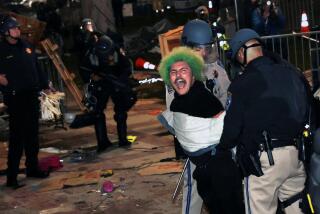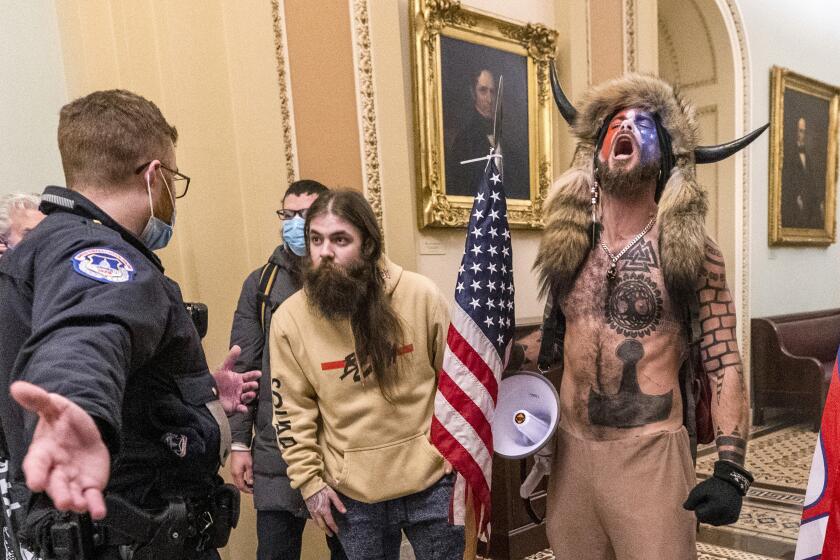Drones tested as tools for police and firefighters
WASHINGTON — On a chaparral-covered hillside 40 miles north of Los Angeles in June 2010, researchers from the Department of Homeland Security hid a device the size of a pack of cigarettes that emitted a safe pulse of low-grade radiation.
It was a stand-in for a dirty bomb, or fallout from a nuclear meltdown.
Nearby, a pilot toggled a joystick, and a gray drone with the wingspan of a California condor banked through the sky. As the plane’s sensor sniffed for radioactive isotopes, law enforcement officers and firefighters watched a portable controller that looked like an oversized Game Boy.
In minutes, a warning signal glowed on the screen. The drone had detected the radiation.
“Think of Fukushima or some awful event like that,” said Cmdr. Bob Osborne, who hosted the tests as part of his job finding and buying new gadgets for theLos Angeles County Sheriff’s Department. “We wanted to know: Will it even be able to detect radiation? And it did.”
The experiment in Los Angeles County was the first in a rapidly expanding $3.2-million effort by the Department of Homeland Security to accelerate the use of drones by police and fire departments.
In October, the federal department is planning to invite drone manufacturers to Ft. Sill, Okla., where their aircraft will be scored on how they perform in a series of scenarios, such as a hostage standoff, an earthquake or a hazardous material spill. A rating system will rank the capabilities of the various models.
It’s like a Good Housekeeping Seal of Approval for drones.
But some legal experts are worried about the effect of surveillance drones in U.S. skies.
“This is putting the cart before the horse where DHS and other federal agencies are looking to put money toward drone use without looking at what it means for privacy and civil liberties,” said Jennifer Lynch, a lawyer with the Electronic Frontier Foundation in San Francisco.
DHS has awarded hundreds of thousands of dollars in grants to at least 13 police departments to buy small surveillance drones. But safety restrictions imposed by the Federal Aviation Administration — and the fact that some models have proved difficult to use — have kept most on the ground.
That could change soon. Congress this year passed a law requiring the FAA to ease restrictions on commercial drone use in U.S. airspace by 2015. Next year, the administration is expected to issue a rule allowing law enforcement and first responders to fly small unmanned aerial vehicles.
The Ft. Sill center will test drones in “real-world situations where individual lives are in imminent danger,” according to a recent presentation given by John Appleby, the DHS program manager for the tests, who also indicated that Homeland Security officials are drafting recommendations on how to protect people’s privacy.
But some in Congress are concerned. Rep.Edward J. Markey(D-Mass.), co-chairman of the Bipartisan Congressional Privacy Caucus, proposed a bill Monday that would require police to tell the FAA how they would “minimize the collection and retention of data unrelated to the investigation of a crime,” among other restrictions. Republican lawmakers have introduced similar legislation.
Some lawmakers have also criticized DHS, which has a fleet of 10 Predator B drones for border security, for not addressing safety and privacy concerns earlier.
“DHS seems either disinterested or unprepared to step up to the plate to address the proliferation of drones, the potential threats they pose to our national security, and the concerns of our citizens of how drones flying over our cities will be used, including protecting civil liberties of individuals under the Constitution,” Rep. Michael McCaul (R-Texas) complained after the department declined to send an official to an oversight hearing he had called about domestic use of drones.
For the tests in Los Angeles County, Monrovia-based drone manufacturer AeroVironment was invited to fly three types of drones. The officials tested the Wasp, Raven and Puma — all between 4 and 15 pounds — for their ability to detect nuclear radiation, track a gun tossed by a fleeing suspect, find the source of a building fire and assist searchers in finding a missing person, among other challenges.
The first tests were conducted over a three-day period at the Los Angeles County Fire Department’s 160-acre Del Valle Regional Training Center in rural Castaic. Another round followed in May 2011 in the San Gabriel Mountains north of Pasadena at a remote police helicopter station at Barley Flats, where the Sheriff’s Department sent actors out on the trails to pretend to be lost hikers.
The sheriff’s office had planned to test drones on a movie set in Downey designed to look like a suburban street, but the FAA wouldn’t allow them to fly so close to other commercial air traffic. FAA officials also rejected a plan to fly unmanned planes over the Port of Long Beach to see if they could duck under the morning fog layer to track small boats that might smuggle drugs or attack a ship.
Police and firefighters found the smaller drone, the Wasp, was simple to unpack and launch, but winds easily buffeted the aircraft, shaking the camera. The small screens used to monitor the video from all three drones made it difficult to spot hikers in the mountains.
Osborne, the commander with the Sheriff’s Department, was impressed with the drones, but said, “We’re not going to buy anything until the technology is a little bit more mature and the flying regulations are further along.”
More to Read
Sign up for Essential California
The most important California stories and recommendations in your inbox every morning.
You may occasionally receive promotional content from the Los Angeles Times.











